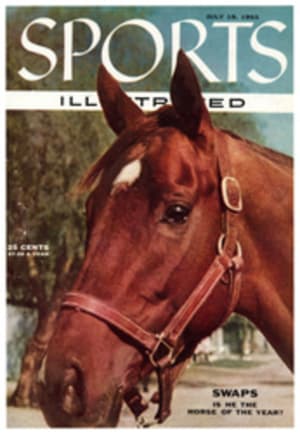
DEATH OF A SHROPSHIRE LAD
On the morning of August 25, 1875, Captain Matthew Webb of Dawley, Shropshire, 27 year-old master of an English sailing vessel, woke up in a Calais hotel to find himself famous. The day before he had done the impossible: he had swum the English Channel, the first person in history to do so. While he slept that night the world heard all about him—how he had plunged off the Admiralty Pier at Dover and had battled currents and high seas for 21¾ hours over a 50-mile zigzag course to reach the sands at Calais.
Days of glory awaited the Shropshire lad. At Dover, where a huge throng welcomed him upon his return, the mayor of the city said, "In the future history of the world I don't believe that any such feat will be performed by anyone else." Webb became a national hero. Crowds mobbed him wherever he went. Dignitaries clapped him on the back. A public subscription organized by Lord Stanhope netted him £2,000. The Prince of Wales opened his royal purse and handed him £5,000. Thousands flocked to see the stocky 5-foot 8-inch blond captain cleave the waters with the powerful stroke that had conquered the Channel. (Webb used the breaststroke, the crawl being then unknown. At the rate of 25 to 27 strokes a minute, he swam low in the water, with mouth and nose under, blowing porpoise-like as his head emerged.)
Acclaimed as the world's greatest swimmer, Webb toured English resort beaches giving swimming exhibitions and staging feats of endurance. A couple of years of this, however, and interest in him began to slacken. He became more and more of a stunt man and would pick up a few purses by betting that he could stay in the water for a certain number of hours. Once at Scarborough he won £400 by swimming about for 74 continuous hours.
He came to this country in 1879 and swam from Sandy Hook to Coney Island, covering 16 miles against strong tides in eight hours. Following this feat, Webb returned to England and acquired a wife and a manager named Fred Kyle.
In 1881 he reappeared in the United States to bolster his diminishing fortune, but little money came in. He won $1,000 by defeating George H. Wade of Brooklyn, "the champion ocean swimmer of America," in a five-mile match race at Brighton Beach, near Coney Island. In Boston he remained in a tank of water for 128¼ hours (with a 15-minute interval of rest at the end of each 24 hours). The stunt failed to cause much excitement and brought him no money.
In the summer of 1883 Kyle got him booked at Nantasket Beach, Mass., to give daily exhibitions of swimming. The captain was now no longer the shining Shropshire lad who had brought fame to England eight years before. At 35 he weighed 200 pounds, and his closely cropped hair was thin on top. With him at Nantasket, where he was no great attraction, lived his wife and their two small children.
What was needed, Manager Kyle thought, was another big one like the Channel swim—something that no man had ever tried before. Like the Niagara River rapids below the falls, for instance—perhaps the angriest stretch of water on earth. If Webb could get through them he would again have done the impossible, and there would be a fortune in it.
A GORGE OF BOILING WATER
At the foot of Niagara Falls there is a huge circular gorge of constantly boiling water. The Niagara River empties out of the gorge and is relatively quiet for a brief stretch. Then, about two miles below the falls, it gathers momentum as the walls of the river close in. Through this ever-narrowing funnel a tremendous volume of water, wild for want of room, reaches a pace of nearly 30 miles an hour and throws the surface into a series of great billows that break up to 30 feet high. These are the Whirlpool Rapids, some three-quarters of a mile in length, and below them is the Whirlpool itself, a giant disk of foaming eddies and furiously revolving water. Uprooted trees caught in the rapids are tossed end over end like twigs and, in the Whirlpool below, have been known to boil about for weeks at a time before escaping downriver.
On June 10, 1883 the captain came to Niagara Falls to examine the rapids. Attired in a pearl-colored derby and gray frock coat, he drove along the river on the Canadian side and surveyed the rapids from the heights above. Then he walked down to the water's edge for a closer view. A few minutes' study seemed to satisfy him. "A rum bit of water," was his only comment. Kyle meanwhile was trying to persuade the proprietors of the various falls hotels to post $1,000 as a guarantee and the railroads to run extra trains. He asked for 40% of the excursion proceeds, but neither hotels nor roads were interested, and the two men returned to Nantasket.
A few weeks later they were back in Niagara Falls determined to stage the event anyway. The reason? The captain, said Kyle, would draw such great crowds at Nantasket upon his return from Niagara that he would receive $2,000 a week. Few believed him. Kyle distributed 200 circulars to newspapers throughout the United States and Canada, announcing that the feat would take place on the afternoon of July 24 and that Captain Webb would be in the Clifton House at 1 o'clock that day to meet members of the press. During the interview, at which only about half a dozen reporters were present, the captain played with a red clover blossom as he outlined his plan.
He would, he said, dive into the river and let the current take him down toward the rapids. He would try to stay in the middle, away from the rocks along the river's edge. "When the water gets very bad I will go under the surface and remain beneath until I am compelled to come up for breath. That will be pretty often, I'll wager. When I reach the Whirlpool I will strike out with all my strength to keep away from the suction hole in the center. It may take me two or three hours to get out of the Whirlpool, which is a quarter of a mile long. When I get through I will try to land on the Canadian side, but if the current is too swift I will keep on down to Lewiston [five miles below] on the American side."
As the hour approached, some 500 spectators had gathered on the suspension bridge down-river, upon the cliffs on either side and along the river's edge. There was but one comment from the crowd: "If he goes in he'll never come out alive." No one knew this better than John McCloy, a veteran ferryman who had rowed back and forth across the calmer parts of the river for years. A few minutes before 4 Captain Webb walked alone from the Clifton House to the foot of the cliff where McCloy was waiting in his little skiff. He quickly undressed, tied a red cotton breechclout around his loins (the same one he wore when he swam the Channel) and stepped into the skiff. As McCloy rowed slowly downstream he asked his passenger if he had a family and how much money he had left from the Channel swim. "Most of it is gone," Webb answered. "Well," said McCloy, "if I was you I'd go ashore and keep the rest." There was no reply and the two men went on in silence, as far down as the ferryman dared take the skiff.
THE CAPTAIN'S LAST PLUNGE
Far below on the suspension bridge, where the first wild water began, the crowd saw the captain stand up in the boat and plunge into the middle of the river. He came to the surface and with slow sweeping strokes went straight ahead toward the bridge. For several minutes he swam through smooth green water, gathering speed as he went, then hurtled like a startled salmon under the bridge and, a moment later, came to the first huge wave of the rapids. Instantly he vanished, but in another second he was thrust to the surface. For a hundred yards or more the crowd caught glimpses of him as he was tossed wildly from crest to crest. Again he was engulfed and for more than 200 yards no one saw him, until suddenly he shot upward and spun crazily about, nearly erect above the water. Dead or alive, none could say. Then a rushing mountain of water closed over him, and he was seen no more. Less than four minutes had elapsed from the time he hit the first wave until his final disappearance.
Kyle left for Nantasket to comfort the captain's wife. Four days later searchers found the body down near Lewiston. It was face downward in the water, the arms and legs extended as though in the act of taking a breast-stroke. A fisherman towed the body into a boathouse where it was guarded by a half-drunken sailor until officials could be summoned. Later an examination by three doctors revealed that there were no bones broken and no injuries sufficient to cause death; nor had Captain Webb been drowned. Their verdict was that life had been pressed out of him by the force of the water and that "no living body can, or ever will, pass through the rapids alive."
Today in a Lewiston cemetery "by brooks too broad for leaping" lies the grave of the Shropshire lad. "And the name died before the man." So run the lines of the poet A. E. Housman, another Shropshire lad.
PHOTO
FAME AND FORTUNE came suddenly to Webb, the 27-year-old Shropshire sea captain, when he swam from Dover to Calais in 1875. He covered 50 miles and it took him 21¾ hours.

